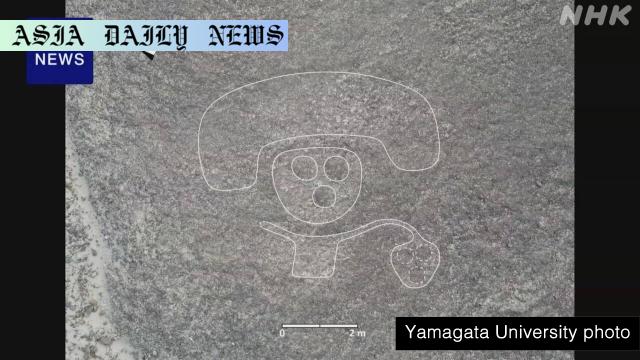Nazca Lines researchers from Japan’s Yamagata University announced the discovery of 248 new geoglyphs in Peru’s iconic World Heritage Site.
Researchers from Yamagata University in Japan found 248 new geoglyphs in Nazca, Peru.
The discoveries include images of a priest, corn, a fox, and symbolic figures.
The team suggests these ancient drawings may share stories or convey beliefs.
Photos of the findings are currently displayed at the Osaka Expo’s Peru Pavilion.

Exploring the Nazca Lines and the Latest Discovery
The Nazca Lines, a UNESCO World Heritage site, have long been an enigma for historians and archeologists. Located in the arid coastal plain of southern Peru, these geoglyphs span about 500 square kilometers, featuring massive images of animals, plants, and geometric shapes etched into the ground. The mystery surrounding their origin, purpose, and significance continues to fascinate researchers and travelers alike. Recently, a breakthrough discovery announced by a team from Japan’s Yamagata University adds another thrilling chapter to this mysterious narrative.
Under the leadership of Sakai Masato, deputy head of Yamagata University’s Nazca Institute, the team uncovered 248 previously unreported geoglyphs within the Nazca province. This discovery, made possible through extensive field surveys coupled with artificial intelligence technologies, highlights the potential of modern scientific methodologies in unraveling ancient mysteries. These 248 geoglyphs—depicting a range of figures including a priest holding a decapitated human head, representations of corn, and an image of a fox—provide crucial insights into the cultural and spiritual practices of the ancient Nazca civilization.
A Deeper Dive into the Findings
The find was particularly significant because it indicated clustering of similar-themed images in distinct areas. These clusters hint at the possibility that geoglyphs were not just random artistic expressions. Instead, they may collectively convey stories, beliefs, or even instructions important to their creators. Sakai highlights that these lines could have served as a form of media—communicating key cultural narratives or memories from generation to generation.
More compellingly, the discoveries underscore the importance of advanced technology in deciphering historical secrets. The integration of AI into archeological practices allowed researchers not only to expedite the discovery process but also ensured precision during surveys. This methodological leap presents broader implications for archeology worldwide, offering avenues for unexplored terrains to be studied intensively.
The Symbolism of the Nazca Lines
Why exactly the Nazca civilization created these colossal and intricate designs remains one of the most debated topics in archeology. Speculations range from astronomical calendars to water rituals and messages to deities. The added data supplied by the newly discovered geoglyphs provides additional clues that align with these theories while also opening up new possibilities for interpretation.
One of the new drawings that stood out is that of a priest holding a decapitated head—a figure suggestive of ceremonial or ritualistic implications. The image of corn, a staple crop in ancient Peru, further highlights the Nazca people’s intimate connection with their agricultural lifestyle and environment.
The inclusion of animal imagery, such as foxes, often interpreted as symbols of cunningness or adaptability in folklore, sheds light on the Nazca worldview. Each symbol, when contextualized within its cultural framework, can provide us with a keynote into understanding the people who created icons that withstood centuries.
Future Implications for Research
The significance of these new geoglyphs goes beyond merely adding to the repository of Nazca Line drawings. This discovery reiterates the enduring relevance of interdisciplinary approaches in archeology. By pairing humanities and sciences, researchers can not only locate the lines more efficiently but also bridge gaps in historical understanding.
This wealth of unexplored meaning within the Nazca Lines warrants deeper investigation. Since the modern world continues to encroach on historical sites, preserving the Nazca Lines through advanced imaging and virtual modeling can ensure they survive for generations to study and admire.
Photos showcasing the newly found geoglyphs can currently be viewed by the public at the Osaka Expo’s Peru Pavilion—a tribute to the collaboration between archeological curiosity and technological innovation.
Commentary
The Thrill of Discovering Ancient Narratives
The latest revelations from the Nazca Lines provide not only an opportunity to revisit ancient history but also an invitation to imagine. The Nazca civilization, though long gone, continues to make its presence felt through these designs etched into the Earth—a testament to the human drive to communicate and create. It’s fascinating to think that these lines could have served as an early form of media—intent on conveying beliefs and stories that mattered deeply to an ancient society.
What excites me most about these discoveries is the integration of AI with traditional archeological research methods. It’s proof that by embracing technology, we can achieve breakthroughs in fields that were considered slow-moving only a decade ago. The Nazca Lines are a prime example of how modern tools can decode the mysteries of our past more efficiently, bringing forgotten narratives to light.
Preservation and Awareness
What also strikes me is the fragility of these priceless cultural artifacts. While the desert environment has preserved them for thousands of years, they are not immune to human interference. Thus, raising awareness and ensuring their protection should remain a priority for governments, institutions, and individuals globally. It’s heartening to know that advancements like AI have brought us closer to understanding the Nazca Lines—but with increased awareness, let us also act as stewards to safeguard them.
As we marvel at the ingenuity and fervor of the ancient Nazca people, the challenge for us is to honor their legacy by weaving their stories into our understanding of human history. Every discovery, like the 248 geoglyphs found this year, is a reminder that history is alive, vibrant, and waiting to be rediscovered.


